
Namaste.
Quiz:
The quiz this week is about the Gond tribe, the tribe in central India of which Mowgli would have been a part. Which of these statements are true?
1. The Jungle Book is set in an area of Central India called Madya Pradesh.
2. Kipling wrote about this area while he was camping on the banks of the Wainganga itself.
3. The Wainganga River is a real river, but the area around it is not a rainforest.
4. Today in the Seoni District, there is a tiger preserve, where 50 tigers and 30 leopards can be hunted from hired jeeps or airplanes.
5. The villagers that Mowgli encountered would have been members of the Gond tribes.
6. The Gond people practice Hinduism and also animism, which means they worship animals and ancestral spirits.
7. Gond tribes survived by trading their art with neighboring cultures.
8. Gond tribal art usually portrays technological wonders like steamboats and front loaders.
9. A ghotul is a tribal dormitory where young girls and boys go to live apart from their families.
10 Gond people believe that freedom and happiness are more to be treasured than any material gain, that friendliness and sympathy, hospitality and unity are of the first importance.
Project: I'm going to condense two weeks together here, to show you how to get this project done.
Step 1:
Materials:
White piece of paper
Pencil
A sense of what the Gond tribal paintings look like, and what kinds of elements they would include.
The Gond tribes painted things they would see in their everyday environment. Ask the children what kind of elements and motifs they would expect to see in a Gond tribal painting, and then ask them to create a sketch of the painting they would like to do. Here are two examples of the drawings the kids came up with:

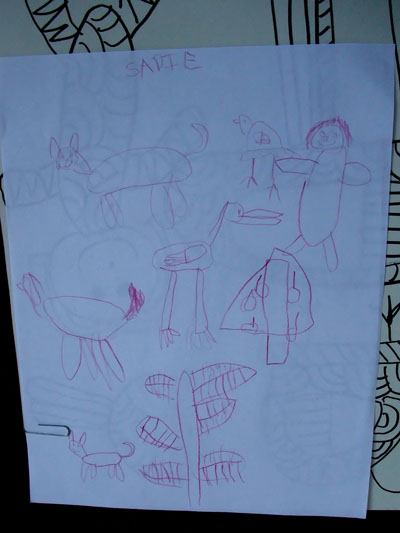
Step 2:
Materials:
White poster board
Pencil
Black Sharpie
This is where you, the teacher, at home, transfer the sketches the children have done onto posterboard, and add the design elements common to the Gond style. This is hard. Don't expect to get it perfect or symmetrical -- freewheeling a little bit is fine. Here are some examples of my attempts to translate the children's art into a workable poster:
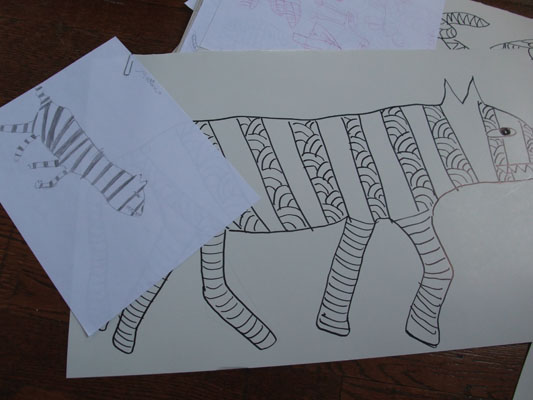
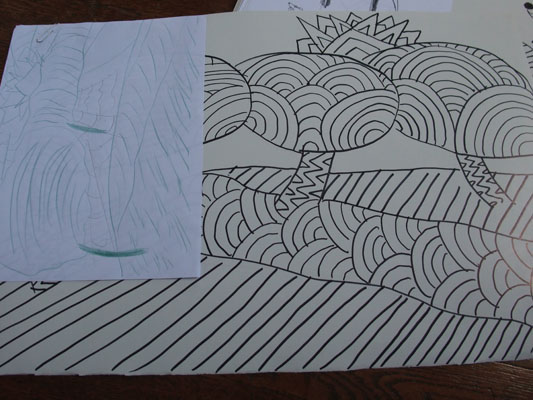
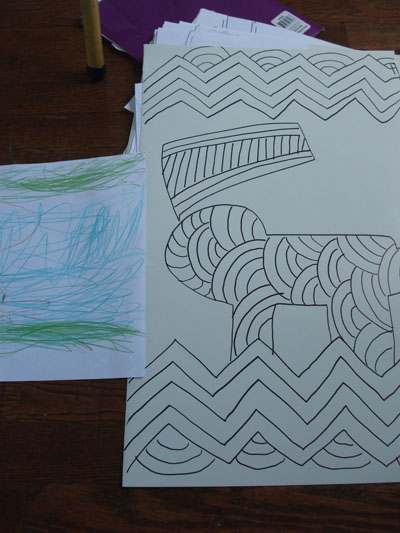
Step 3:
Materials:
Poster paints
Lots of Q-tips
Paper towel
Outline drawings for each child
Make an example to show them how the paintings may end up looking. Here's my example:

Set each child up with paper towel, some poster paints, and a pile of Q-tips. Demonstrate the way you fill in the outline with "dot dot dot" action. Some of the older children may want to branch out into doing small lines to fill in the areas, or other fancy stuff. The little ones should stick to dot-dot-dot to make their paintings colorful. Emphasize that the colors do not have to be realistic. Emphasize that it does not have to be perfect -- folk art is neither exact or mathematical. Let them know that if one of their Q-tips gets squishy or frayed or otherwise irritating, they should ditch it and use a new one. Expect each kid to go through about 20.
Here are some pictures from our painting day:
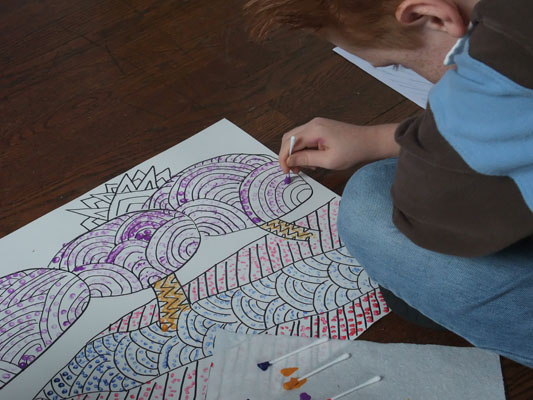
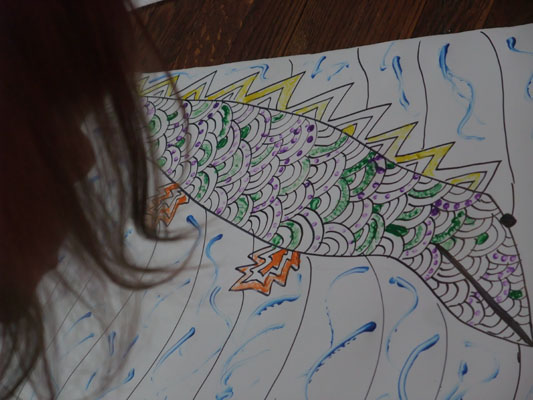
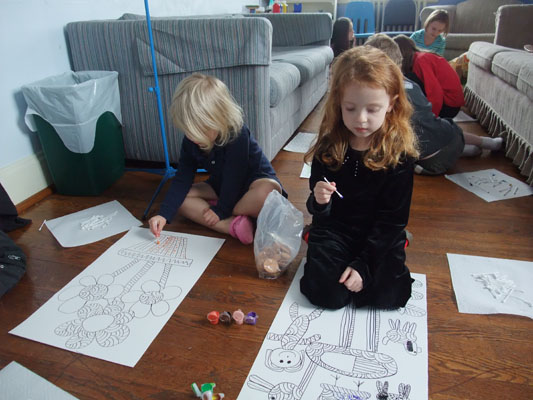
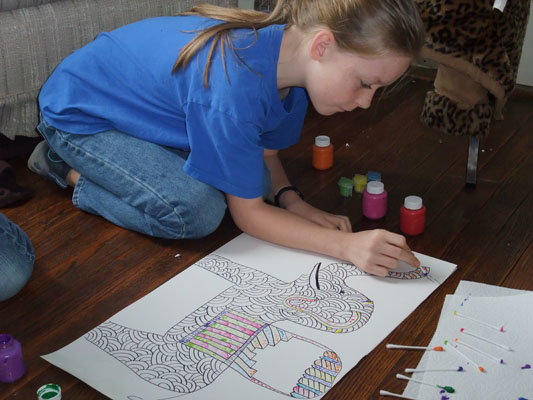
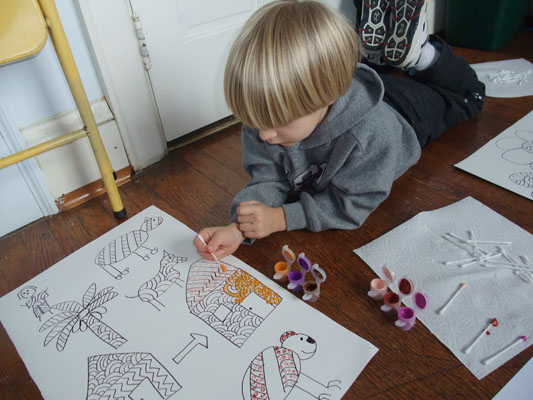
For more pictures, check out our Jungle Book Flickr set. :)
Story: In the last few weeks of class, we discussed Mowgli's place in the world. Does he belong in the village or in the jungle? I left this as an open-ended question, and obviously there is no right answer. It was interesting to hear the children discussing it. I asked them where they felt they belonged -- more comfortable in the country or in the city? This led us to more interesting questinos: Is man an animal? Can people ever be truly civilized? What is perfect "city" behavior? What is perfect "jungle" behavior? Are there people you know that remind you of different animals? What animal would you be if you could? Would you be happy living the life of a wolf/snake/crocodile?
To me, these questions are more significant for young readers than the issues of race, colonialism, and caste that inevitably come up surrounding this text. They are some of the fundamental questions of humanity, and yet very accessible, in the context of Mowgli and his story, to even the youngest ones. We did talk about race and the empire, and we didn't shy away from some of the more troubling aspects of the stories. However, what I hope the children come away with is a little more awareness of the complexity of point-of-view. I hope they remember reading about seals from the point of view of scared seals and the hungry hunter, reading about the lawful jungle and the unlawful village, about the Gond tribe and the wolf pack. Maybe when they return to these themes and ideas later, they will be able to accomplish a deeper understanding of the tough issues too.
Song and Dance: We had several children who memorized all of "If" and all of "Mandalay." What an amazing accomplishment! For our final show, we had the enrichment class doing the first two verses and the academic class doing all of the poems -- it was a great performance! We also did a Bhangra dance using all 20 of the moves we worked on.
Here are a few videos for you:
Academic track kids doing "Mandalay":
Enrichment track kids doing "If":

oh my GAWD!!! Do you suppose his eyes hurt after keeping them crossed for so long??
ReplyDeleteI love your blog alot! It's gorgeous and the pics are great! The children are so cute!
ReplyDeleteI suggest a great web site:
ReplyDeletehttp://www.artribal.com
Oliver